 William III was born in The Hague on November 4, 1650 to William II, Prince of Orange, and Mary Stuart, daughter of Charles I. His father William II died before his birth on October 27th of that same year. William was brought up in the Protestant Faith and spoke English, French, Dutch, German, Latin and Spanish.
William III was born in The Hague on November 4, 1650 to William II, Prince of Orange, and Mary Stuart, daughter of Charles I. His father William II died before his birth on October 27th of that same year. William was brought up in the Protestant Faith and spoke English, French, Dutch, German, Latin and Spanish.
In 1667, Louis XIV of France had attacked the Spanish Netherlands in his attempt to claim his wife, Marie-Therese of Spain’s, inheritance to the Spanish throne. Holland, England and Sweden formed the Triple Alliance in 1668, forcing Louis to sign the Treaty of Aix-la-Chapelle and end the War of Devolution against Spain.
William III made his first visit to England in 1670 at the invitation of Charles II. In that same year, Louis XIV signed the Secret Treaty of Dover with Charles to restore Roman Catholicism to England. Louis purchased the neutrality of England and Sweden to again invade Holland, and by 1672 had occupied large areas of the Lowlands. The Dutch stopped the French advance on Amsterdam by opening the dikes and flooding the countryside. Under the command of Michiel de Ruyter, the Dutch were defeating the English and French fleets at Southwold Bay at about the same time.
In 1672, William took over Dutch leadership from Jan de Witt, grand pensionary, and by the end of 1673 had driven the French from Dutch soil. William made peace with England in 1674, and with Spanish and Austrian support, made peace with France in 1678 with the signing of the Treaty of Nijmegan.
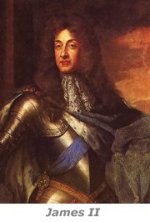 James, Duke of York, was the second son of Charles I, brother to Charles II and successor to the English throne. At the Restoration in 1660, he returned to England after having served in both the French and Spanish armies. There, he was married to Anne Hyde, daughter of the 1st earl of Clarendon. He was made Lord High Admiral and served in the Dutch Wars of both 1664 and 1672. Anne Hyde died in 1671 leaving James with two Protestant daughters.
James, Duke of York, was the second son of Charles I, brother to Charles II and successor to the English throne. At the Restoration in 1660, he returned to England after having served in both the French and Spanish armies. There, he was married to Anne Hyde, daughter of the 1st earl of Clarendon. He was made Lord High Admiral and served in the Dutch Wars of both 1664 and 1672. Anne Hyde died in 1671 leaving James with two Protestant daughters.
The daughter of James and Anne, Mary was brought up the Protestant Faith. In November of 1677, at the age of fifteen, she was married to her first cousin, William of Orange, and shortly after set sail for The Hague.
At twelve years her senior, Mary found William to be repulsive. She was terribly homesick living in Holland. After learning of her husbands long time affair with one of her ladies-in-waiting, Elizabeth Villiers, Mary became completely devoted to William and eventually came to love both the man and his country.
Perhaps as early as 1672, James became a Roman Catholic and, through the influence of Louis XIV, in 1673 married Mary Beatrice d’Este of Modena, daughter of Alfonso IV, Duke of Modena. Mary of Modena was a devout Roman Catholic and therefore unpopular in Protestant England.
 James’ resignation of admiral due to the Test Act coupled with his marriage to the devout Roman Catholic, Mary of Modena, caused the pair to become increasingly unpopular in England. The false accusations of a Popish Plot to assassinate Charles II and to hasten the succession of the Catholic James in 1678 brought about efforts of the Scottish Presbyterian Whigs to exclude James from the succession. Charles II supported his brother by preventing the passage of the Exclusion Bill and dissolved Parliament. James was sent out of the country.
James’ resignation of admiral due to the Test Act coupled with his marriage to the devout Roman Catholic, Mary of Modena, caused the pair to become increasingly unpopular in England. The false accusations of a Popish Plot to assassinate Charles II and to hasten the succession of the Catholic James in 1678 brought about efforts of the Scottish Presbyterian Whigs to exclude James from the succession. Charles II supported his brother by preventing the passage of the Exclusion Bill and dissolved Parliament. James was sent out of the country.
In 1683, Louis XIV invaded and looted the Province of Orange and persecuted the Protestants only to lead to William’s undying hatred of him. In the same year on the 23rd of June, Sir James Caldwell, grandson of William of Straiton, was made a baronet of Ireland, a Noble’s title usually granted for military or other honorable service directly to a feudal superior.
When Charles died on February 6th 1685, his brother succeeded peacefully to the throne as James II, King of England. The new king favored autocratic methods, reviving the old ecclesiastical court of high commission and interfering with the courts and with local town and county government. He became obsessed with the idea of a Catholic England and began to fill positions of authority and influence with Roman Catholics.
 On October 18 of that same year, Louis XIV revoked the Edict of Nantes, which had guaranteed freedom of worship to French Protestants known as Huguenots. 50,000 Huguenot families fled France to Switzerland, Germany, England, America, Ireland, and to Holland where many would join armies of William of Orange.
On October 18 of that same year, Louis XIV revoked the Edict of Nantes, which had guaranteed freedom of worship to French Protestants known as Huguenots. 50,000 Huguenot families fled France to Switzerland, Germany, England, America, Ireland, and to Holland where many would join armies of William of Orange.
Within three years, both the old nobility and emerging commercial class had been totally alienated by James II. Mary of Modena gave birth to a male heir, James Francis Edward, which interfered with Parliament’s wish that James’ Protestant daughter, Mary, would succeed to the throne upon the death of her father.
Protestant members of Parliament were thoroughly disgusted with James and a document was drafted by Henry Sidney formally inviting Mary and her husband, William of Orange, to take the throne of England with as little delay as possible. The paper was signed by “The Immortal Seven”, Lords Shrewsbury, Devonshire, Dunby, Lumley, Compton (Bishop of London), Edward Russel and Henry Sidney.
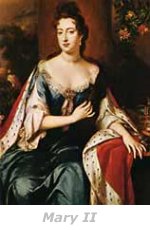 William landed at Torbay in Devonshire with an army of 15,000 and advanced to London with virtually no opposition. James’ forces quickly deserted him and he fled to France, stopping only to throw the Great Seal of England into the Thames. Some fishermen captured him before he could cross the Channel and was brought back to London. William, not wanting to make James a martyr or a center for Catholic resistance, contrived to let his father-in-law escape again.
William landed at Torbay in Devonshire with an army of 15,000 and advanced to London with virtually no opposition. James’ forces quickly deserted him and he fled to France, stopping only to throw the Great Seal of England into the Thames. Some fishermen captured him before he could cross the Channel and was brought back to London. William, not wanting to make James a martyr or a center for Catholic resistance, contrived to let his father-in-law escape again.
In early 1689 a Bill of Rights would redefine the relationship between monarch and subjects. The Bill of Rights stated that certain acts of James II were illegal and henceforth prohibited; that Englishmen possessed certain inviolable civil and political rights; that James had forfeited the throne by abdication and that William and Mary were lawful sovereigns.
William and Mary accepted the invitation to rule as joint sovereigns instating this Declaration of Rights as a condition for ascending the throne. The royal power to suspend and dispense with law was abolished, and the crown was forbidden to levy taxation or maintain a standing army in peacetime without parliamentary consent. Other provisions of the Bill of Rights included that the succession of the throne would pass to the heirs of Mary, then to Princess Anne and her heirs, and that no Roman Catholic could ever be sovereign of England.
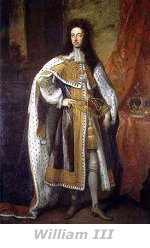 Backed by money and troops provided by Louis, James made an effort to restore himself by landing in Kinsale, Ireland on March 17, 1689. Ireland’s Catholics rallied to James, beginning with Richard Talbot, Earl of Tyrconnell, and within a month controlled the entire county except Enniskillen and Derry.
Backed by money and troops provided by Louis, James made an effort to restore himself by landing in Kinsale, Ireland on March 17, 1689. Ireland’s Catholics rallied to James, beginning with Richard Talbot, Earl of Tyrconnell, and within a month controlled the entire county except Enniskillen and Derry.
Londonderry was the last refuge for many thousands of Protestants from all over Ulster who feared that they would be mercilessly slaughtered as had happened during the Rebellion in 1641.
On 7th December 1688, when the first companies of Redshanks had crossed the Foyle by ferry, a group of thirteen young Apprentice Boys ran to close the city gates. On 18 April 1689, James came to Derry and summoned the city to surrender. Greeted with cries of “No surrender!” the siege began. The Jacobite Army set up two attacking positions on the water, using their gun batteries to fire across the River Foyle into the walled City. French Soldiers were also based in the Creggan area where they would fire across the bog into the city itself.
Joseph Caldwell, great grandson of William Caldwell of Straiton and nephew of Sir James, was thirty-two years when he served in defense of Derry. The people inside the walled city not only suffered from attacks by cannonballs and mortars, a floating boom was placed across the River Foyle in June to prevent supplies from reaching the city. Thousands died from starvation and disease.
At the end of July, three merchant ships called the Mountjoy, Phoenix and Jerusalem sailed towards the boom barricading the river. Protected by the frigate Dartmouth, the relief ships eventually broke through the boom to unload their cargo of food and supplies to the starving people. By the evening of the 31st of July, the Jacobites could be seen burning their encampments and marching off towards Lifford. Joseph Caldwell died on September 30, 1730 and is buried on his farm in Lifford, Ballycogan Parish, County Donegal.
In August 1689 Marshal Schomberg landed at Bangor with 20,000 troops and, with Ulster secure, pushed south as far as Dundalk. Seventy-three year old Schomberg had earned his marshal’s baton leading French forces during the Dutch Wars, but his Calvinist convictions compelled him to leave France after Louis revoked the Edict of Nantes. He commanded twenty-two infantry battalions, two regiments of dragoons, and eight cavalry regiments, most of which were newly raised in England. The backbone of the army consisted of two battalions of Dutch Guards and four regiments of Huguenots.
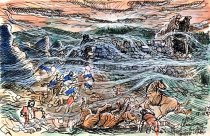 Schomberg preferred the Frenchmen to the Irish and Ulster-Scot troops from Enniskillen and Derry, holding a low opinion of the latter for their thirst for plunder and massacring of the defeated. Within three months he had lost half his men and was forced to appeal to William for reinforcements.
Schomberg preferred the Frenchmen to the Irish and Ulster-Scot troops from Enniskillen and Derry, holding a low opinion of the latter for their thirst for plunder and massacring of the defeated. Within three months he had lost half his men and was forced to appeal to William for reinforcements.
James’s army blocked further progress towards Dublin, but there was no battle and the two armies withdrew to winter quarters. Schomberg’s army was in tatters when the plague broke out costing him another 6,000 men. William was not with Schomberg’s results, and probably didn’t appreciate fully the sad state of his army. William decided that when the campaign resumed in the spring of 1690, its success would require his personal presence.
In March 1690 7,000 French regulars strengthened the Jacobite army, but Louis demanded over 5,000 Irish troops in return. James was disappointed to discover that only three of the battalions were French. One battalion consisted of Walloons, and two more were largely made up of Protestant Germans, who until recently had been French prisoners of war.
William himself landed at Carrickfergus on 14 June, 1690, bringing with him thousands of fresh troops, 200,000 pounds sterling in cash, and a train of artillery from the Netherlands that included a prototype of a machine gun capable of firing 150 musket barrels at once, turn over, and fire the same number again.
The Williamite army was well supplied, well trained, and above all well commanded. Reinforcements to Schomberg included 6,000 recruits from England, Huguenots from Switzerland, 7,000 mercenaries rented from King Christian V of Denmark, and about 7,000 Dutch soldiers. Hessians, Prussians and Lowland Scots also accompanied William’s forces, as well as 6,000 Ulstermen who were incorporated into Schomberg’s army, giving William a total strength of about 37,000 soldiers to James’ army of about 25,000.
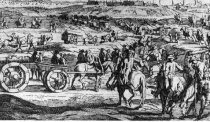 William began the march towards Dublin. There was some resistance near Newry, but the Jacobites soon withdrew to the south bank of the River Boyne. On the 29th of June, a force of 1,300 Jacobites took control of the bridge at Drogheda, while the main Jacobite armies formed three miles upstream near the village of Oldbridge. In spite of its name, there was no bridge near the town, however the river there was fordable at low tide.
William began the march towards Dublin. There was some resistance near Newry, but the Jacobites soon withdrew to the south bank of the River Boyne. On the 29th of June, a force of 1,300 Jacobites took control of the bridge at Drogheda, while the main Jacobite armies formed three miles upstream near the village of Oldbridge. In spite of its name, there was no bridge near the town, however the river there was fordable at low tide.
William’s armies arrived on the northern hillside overlooking the Boyne and encamped at Tullyallen. Later that day, he accompanied the Dutch Guards in reconnaissance down near the river. A ricochet cannon shot grazed William’s right shoulder, to a great cheer by Tyrconnell’s Irishmen. William soon recovered from the wound, and the torn jacket he was wearing is now in the National Museum in Dublin.
Just after 10:00 a.m. on 1 July, 1690, when the tide was at its lowest, William ordered his troops to attack. Three regiments of Dutch Guards lead the advance, with Ulster regiments from Derry and Enniskillen following directly behind. Once across the Boyne, the Dutch became involved in a fierce battle with Tyrconnell’s crack Irish Guards, who suffered severe losses in the savage house-to-house fighting for Oldbridge.
Seeing the severity of the situation, and knowing that if the Dutch retained their foothold on the south bank and were reinforced the day would be lost, he ordered his cavalry to attack. The Dutch were able to repel the attack, while the Irish Guard rallied for another. Richard Hamilton ordered the Irish infantry to meet the English and Huguenot regiments that were by then crossing the river, but instead, they turned and fled.
Although Huguenot commander Colonel Pierre Ruvigny, comte de Caillemotte, and Marshall Schomberg were both killed in battle that day, Tyrconnell’s force was simply overwhelmed. The “Inniskillings”, as the Enniskillen troops were known, so impressed William that he said, “Gentlemen, you shall be my guards today. I have heard much of you.” before leading the charge at Donore. At 2:00 p.m. of that day, a messenger from Tyrconnell reached James, gasping, “The enemy have forced the pass at Oldbridge. The right wing is beaten.”
From five miles west of Oldbridge, James could see Schomberg’s dragoons outflanking him to the south. His old friend, Antonin Nompar de Caumont, comte de Lauzun, argued that there was no alternative at that point but to withdraw to Dublin soon, before he was cut off. Patrick Sarsfield’s cavalry regiment escorted James to Dublin, then on to the south coast where a squadron of French frigates would take him to France.
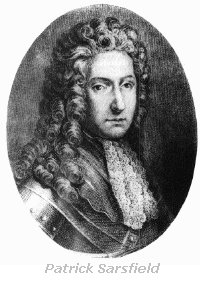 After James had left for France, Tyrconnell was once more Lord Deputy and commander of the Irish army, with discretionary powers negotiate for peace or fight on as he saw fit. Tyrconnell and Lauzun favored negotiating terms with William. Patrick Sarsfield, whom William had once offered the rank of Colonel in his army, had the support of the Irish officers including James’ son, Duke of Berwick, and the backing of the Irish army and the war would continue. Lauzun withdrew to Galway, taking his French soldiers, eight guns and considerable ammunition.
After James had left for France, Tyrconnell was once more Lord Deputy and commander of the Irish army, with discretionary powers negotiate for peace or fight on as he saw fit. Tyrconnell and Lauzun favored negotiating terms with William. Patrick Sarsfield, whom William had once offered the rank of Colonel in his army, had the support of the Irish officers including James’ son, Duke of Berwick, and the backing of the Irish army and the war would continue. Lauzun withdrew to Galway, taking his French soldiers, eight guns and considerable ammunition.
It should be remembered that Louis XIV was at war with both Holland and England at the time, and William might have to retreat from Ireland with a large part of his army to defend against Louis’ advances. If the Irish campaign prolonged into the next year, then there was always hope that events outside of Ireland might help turn the tide against William.
Most of the Irish army had assembled in Limerick by late July. Strategically, Limerick was an important position commanding the southern entrance to Clare and Connaught, as well as a port accessible to sea-going ships.
The geographic location and historical development of Limerick had combined to create two cities in one. The older part of the city was built on the King’s Island at the beginning of the 13th century. Known as the English Town, it was completely walled with a circumference of 1.5 miles, encompassing 35 acres. Bordered by the Shannon and Abbey Rivers, the English Town of Limerick held a naturally defensive position.
South of the English Town, on the other side of the Abbey River, was the Irish Town. Construction began on the Irish Town in 1310 and was completed in 1495. Although it was different in shape from the English Town, its area and circumference was roughly the same. Ball’s Bridge who was built at the narrowest point of the Abbey River in 1340 joined both towns.
Knowing William would soon be reaching Limerick, the Irish set about strengthening the defenses of the city’s strategic points around the walls of Irish Town. John’s Gate was particularly well defended, having a strong point known as the Citadel immediately to the north of the gatehouse, and two forts in close proximity to guard against any approaches. As William’s advanced guards were nearing Limerick on 8 August Tyrconnell withdrew to Galway to join Lauzun, taking three regiments guarding the fords with him.
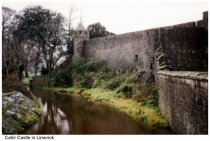 As William’s forces approached Limerick, Irish scouts attacked them. Following the scout’s retreat to Irish Town, William found he was too close when the Irish guns opened fire with a lively cannonade. Having established his camp a safe distance from the city’s guns, William sent a trumpeter to summon the Irish garrison to surrender. With an Irish garrison of about 15,000, and a small force of cavalry inside the city walls, the Jacobites refused.
As William’s forces approached Limerick, Irish scouts attacked them. Following the scout’s retreat to Irish Town, William found he was too close when the Irish guns opened fire with a lively cannonade. Having established his camp a safe distance from the city’s guns, William sent a trumpeter to summon the Irish garrison to surrender. With an Irish garrison of about 15,000, and a small force of cavalry inside the city walls, the Jacobites refused.
William’s forces were now 25,000 after leaving troops to guard many of the towns captured since the Boyne. With his siege train of large artillery still a few days journey behind him and 12,000 less troops, William decided to concentrate his attack on the Irish Town.
The Williamite infantry began preparations for the siege while word was sent to hurry the siege train. A deserter made his way into Limerick and disclosed the location of William’s armament to his enemies. Sarsfield acted quickly and set out with 500 cavalry to intercept the guns and destroy them at Ballyneety, about two miles southwest of Oola, County Tipperary.
Moving by night to escape notice by any of the nearby Protestant estates failed Sarsfield and his forces seen as they passed through Killaloe. The spotters rushed to warn William’s camp, and William immediately ordered out two companies of troops. One to locate the whereabouts of Sarsfield’s forces, and the other to reinforce the siege train. His orders were not carried out for several hours.
Sarsfield’s midnight attack on the siege train took the Williamites completely by surprise and the waggoners and their escort was quickly overwhelmed without reinforcements. In the heat of the attack, a number of non-combatants, including women and children were killed by Sarsfield’s men. Two of the eight guns of the siege train were completely destroyed, while the carriages of the other six had been severely damaged. A large quantity of ammunition was also lost along with other supplies including a number of tin boats which were to have been used as bridging material to help cross the river.
The destruction of the siege train delayed William’s preparations for an assault on the city. It would be another five days before the salvaged guns would finally arrive at William’s camp. This gave the Irish in Limerick almost week to strengthen the walls and fortifications.
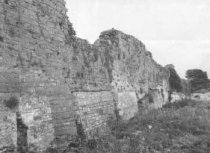 By the second week William’s large artillery had leveled parts of the city wall, and many wharves and houses were on fire or burnt. Behind a large breach in the wall, the Irish placed a battery of guns with others to cover both flanks near the opening.
By the second week William’s large artillery had leveled parts of the city wall, and many wharves and houses were on fire or burnt. Behind a large breach in the wall, the Irish placed a battery of guns with others to cover both flanks near the opening.
At about 2:30 on the afternoon of 27 August, William’s forces attacked the breach in the wall of Irish Town. After more than three hours of hard fighting, the Williamites were finally forced to retreat from the breach and within the city walls. It was during this bloody engagement that one of the more celebrated incidents of the siege is said to have taken place. The women of Limerick are said to have joined with the men hurling bottles and stones at the retreating Williamite forces.
William suffered the loss of over 15,000 men, while the Irish lost only about 300. Although many of his commanders favored continuing the siege the very next day, William knew that the unpredictability of the autumn weather could risk the ability for him to withdraw his artillery and struck his camp for winter quarters, capturing Cork and Kinsale along the way.
William returned to England from Waterford in early September. Lauzun returned to France with Tyrconnell and reported the king’s Limerick cause lost. Tyrconnell, encouraged by the defense of Limerick, said that there was a chance of success and asked for money and men. In January of 1691, Tyrconnell returned from France with money but no men.
In May 1691 a French convoy arrived at Limerick bring much-needed munitions and supplies, and the French general, the Marquis de St. Ruth. St. Ruth arrived to replace Berwick and let Tyrconnell see that he, St. Ruth, alone was in command of the army.
William’s Dutch general, Ginkel, was in charge or the new campaigning season. He strategy was to force a passage of the Shannon upriver from Limerick at Athlone. Ginkel, along with Dutch General Mackay pushed back the small troop of Irish defending the bridge at Athlone, but was unable to remove them from the Connaught side of the town. After nine days of trying to bridge the Shannon, Athlone was taken on the evening of 30 June by the best soldiers in Ginkel’s army, English, Danish, Dutch and Huguenots, who were able to ford the Shannon in waist-deep water and execute a surprise attack on the town.
Tyrconnell and Sarsfield, never ones to agree, both favored the infantry returning to Limerick. St. Ruth wished to stand and fight, which is what they would do.
The next battle of the war would be fought on the side of Kilcommodan Hill, near the village of Aughrim. The Irish army consisted of around 14,000 men, 2,500 horse and about 3,500 dragoons. On 11 July, Ginckel reached the hills opposite Kilcommodan with a larger and better-equipped force than the Irish. Mackay took command of the division that was to force the Pass of Aughrim. Ginckel was to direct the movement on the Pass of Urrachee, and the Duke of Wortemberg would attack the center.
The Williamites were repelled at the bogs, but Ginkel was able to break through the Pass. St. Ruth ordered Sarsfield to send half his troops to the advance, but to remain with the other half. St. Ruth’s ego and unwillingness to share victory with another man may have cost him the battle of Aughrim for when Sarsfield’s detachment arrived, St. Ruth put himself at the head of the advance only to lose his own head to the fire of a Williamite cannon.
Losing their commander sent the Irish forces into disarray, and St. Ruth was not one to explain his strategy or plans to any of his officers. Three hours after the death of the French general, there was not a man of the Irish army left on the field. Sarsfield kept his head both physically and strategically, and was able to organize the successful retreat of the Irish to Limerick.
Ten days after Aughrim, Galway surrendered to Ginkel. Ginkel re-crossed the Shannon at Banagher and proceeded to Limerick, where the main body of his army arrived on 25 August, just a few weeks after Tyrconnell died of natural causes.
Ginkel’s artillery arrived on the 26 August, but due to the condition of the ground it was four days before a battery could be put in place. William wanted the war ended and he empowered Ginckel to give favorable terms. A pardon was offered to all, and the Catholic gentry would be restored to their estates. The offer was opposed and rejected by Sarsfield.
 Sixty guns then opened upon the city directed at Thomond Bridge and King John’s Castle while an English fleet bombarded it from the river. In mid-September Ginkel ordered the Williamites to begin constructing a pontoon bridge at Lanahrone across the Shannon. The following morning the bridge was completed and a party of Williamites crossed over to secure the far bank. With a foothold on the north bank of the Shannon the Williamites were now in a position to invest Limerick on all sides and impose a total blockade.
Sixty guns then opened upon the city directed at Thomond Bridge and King John’s Castle while an English fleet bombarded it from the river. In mid-September Ginkel ordered the Williamites to begin constructing a pontoon bridge at Lanahrone across the Shannon. The following morning the bridge was completed and a party of Williamites crossed over to secure the far bank. With a foothold on the north bank of the Shannon the Williamites were now in a position to invest Limerick on all sides and impose a total blockade.
On 16 September Ginkel again issued a proclamation offering generous terms to the garrison if they would surrender. The Irish were given eight days to accept or, “be answerable for the blood and destruction they draw upon themselves”.
Again Ginckel offered his terms and Sarsfield feared that they would hand the city over to Ginckel if he continued to refuse. The Irish had held out for over a month, but now, completely cut off from the surrounding countryside, and with no sign of further help arriving from France, the garrison was left with little enthusiasm for continuing the fight.
Limerick made one more fight on 23 September. The struggle lasted from dawn until the afternoon when the Irish drums sounded a parley in both the Irish and English towns. At last, Sarsfield accepted Ginkel’s terms to the loud cries of anger from the Irish soldiers and citizens.
 The Treaty of Limerick was signed on 3 October 1691 and was drafted under two headings, military articles and civil articles.
The Treaty of Limerick was signed on 3 October 1691 and was drafted under two headings, military articles and civil articles.
The military articles were short-term and were concerned for the most part with the disposition of the Irish army in the aftermath of the war. The most important provision of the military articles guaranteed that any members of the garrison of Limerick, or of any other Irish garrison within the scope of the treaty, would be allowed to go to France, and that adequate shipping would be provided to transport those who wished to leave. Members of the garrison were also given the option of changing sides and enlisting in the Williamite army, however most left for France with Sarsfield.
The civil articles were concerned primarily with the degree of toleration to be afforded Catholics in Williamite Ireland, and the security of the estates and property of those who had fought on the Jacobite side. The Irish Catholics were to have the right to exercise their religion; to have the rights of citizens; the privilege of sitting in parliament; freedom of trade; and to be preserved from all disturbances. The degree to which both the spirit and the letter of these articles would be subsequently broken would leave Limerick known as the “City of the Broken Treaty”.
The Plantations of Ireland, the Ulster, Cromwellian, and Williamite, had lasted almost a century. More than 81% of the productive land was confiscated from the predominantly Catholic native Irish, and handed over to Protestant settlers from primarily Scotland and England.
The Queen, Mary, died of smallpox in at 32 years in 1694 and without an heir. She was a popular Queen with both the English and the Dutch. William’s political conflicts with her father, James, and sister, Anne, were terribly upsetting to her, however she faithfully sided with her husband.
Anne would take the throne after William was thrown from a horse and died in 1702. Although William’s demeanor toward his wife seemed cold and indifferent, his deep grief over her death showed just how much he loved and respected her.
After a short-lived rebellion in 1715 in an attempt to seat Queen Anne’s Stuart brother, James, the Great Migration to America began and would happen in five great waves of immigration; 1717-18, 1725-29, 1740-41, 1754-55, and 1771-75. Most of the immigrants arrived in Philadelphia and ports on the Delaware River, then moved west and south through the Great Valley, the Shenandoah Valley, and into the Carolinas.
Sources:
- Desmond’s Concise History of Ireland – Jerry Desmond
- Encyclopedia Britanica
- Britannia
- The Plantation of Ireland – Brian Orr
- The Scotch-Irish: The Scot in North Britain, North Ireland, and North America – Charles Hanna
- The Jacobite Era, 1685-1702 By Brian Ó Dálaigh
- The Sieges and Treaty of Limerick (1690-1691) by Frank Noonan
- Patrick Sarsfield and the Williamite War by Piers Wauchope
- Memorial University of Newfoundland
- Strabane District Council
- England in the Reigns of James II and William III by D. Ogg
- Ireland of the Welcomes Magazine
- The Treaty of Limerick by J. G. Simms
